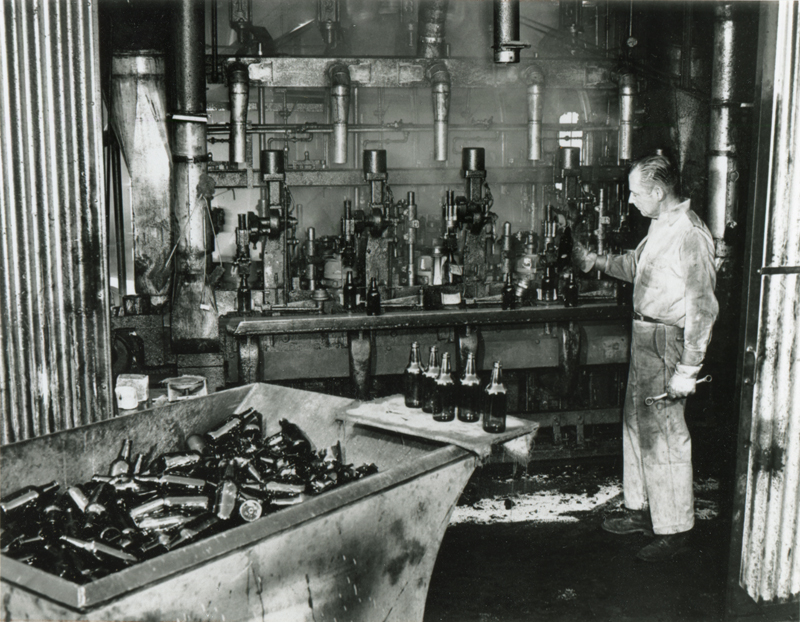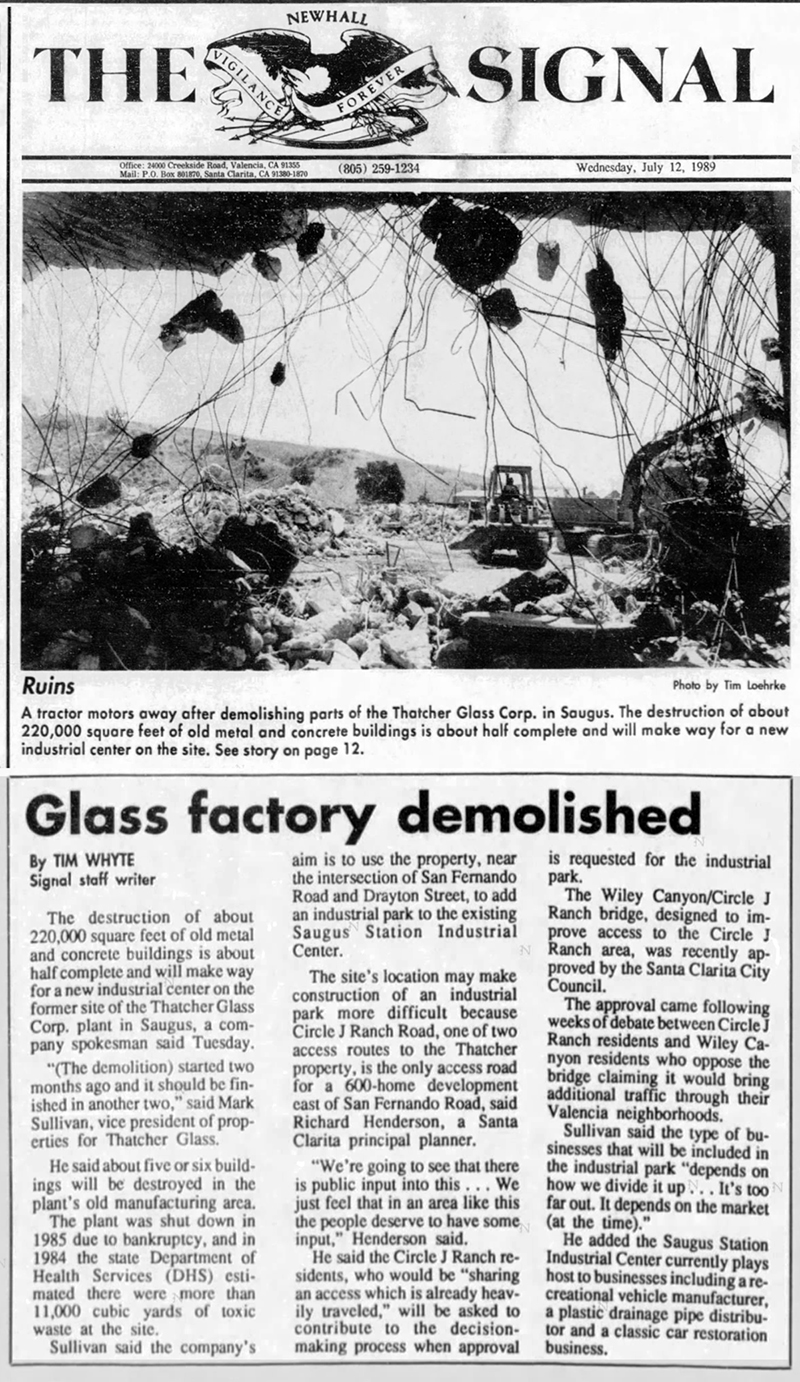|
|
Saugus, California

Click image to enlarge Reynolds (1992) identifies this photograph as showing a Thatcher Glass employee finishing bottles at the Saugus plant in 1955. That would be soon after the plant opened.
Corporate History of Thatcher Glass Webmaster's note: The Saugus plant, located in a series of buildings erected from 1954 to 1965 at 25655 Springbrook Ave., was one of nine Thatcher Glass manufacturing facilities around the country. After the company went bankrupt in 1985, the Springbrook Avenue complex was partially bulldozed (see below) and reborn as the Saugus Industrial Park, with individual spaces leased out. Thatcher Glass Manufacturing was originally incorporated as Thatcher Manufacturing in New York in 1889. In 1905 it was the first company to make milk bottles by automatic machinery. In 1920 Thatcher sold an issue of ten-year 7 percent convertible sinking fund mortgage gold bonds to finance the purchase of three glass companies: Travis Glass Company, Essex Glass Company, and Lockport Glass Company. It also purchased the common stock of Woodbury Glass Company and the milk bottle business of J.T. & A. Hamilton Glass Company. After these acquisitions, Thatcher was manufacturing approximately 50 percent of the milk bottles in the United States and over 115 million condiment bottles per year. It produced milk bottles by owning the exclusive use of both the Owens bottle machine and the Hartford-Fairmont machine. By 1925 the annual manufacturing capacity of the plants, located in states extending from Illinois to Massachusetts, was 150 million milk bottles. Thatcher received somewhat of a setback in 1925 when the Federal Trade Commission ordered Thatcher to divest itself of Essex, Travis, and Lockport Glass companies because of the effect on fair competition within the milk bottle industry. By 1929 Thatcher had an annual manufacturing capacity of 166 million bottles. The stock had been listed on the New York Stock Exchange since 1927, and it was regarded as the largest producer of milk bottles in the country. In 1929 Thatcher earned $921,180 on sales of $5 million, up from a net income of $545,810 on revenue of $4.9 million in 1927. Paper containers for milk slowly increased in popularity during the 1930s yet remained small when compared to the total number of milk containers used in the country. Sales for Thatcher fell and rose over the course of the decade. Sales were $4.2 million in 1930, $2.8 million in 1932, $6.5 million by 1937, and $6.4 million in 1940. In 1933 Thatcher purchased the plant of Peerless Glass Company of Long Island City, New York, and in 1935 it acquired all of the capital stock of Olean Glass Company. Thatcher earned $460,428 from sales of $12.8 million in 1944. In 1947 Thatcher Manufacturing changed the corporate name to Thatcher Glass Manufacturing. In the post-war years, Thatcher opened and closed various manufacturing facilities and began to broaden the glass products it produced. In 1951 it acquired McKee Glass Company, a manufacturer of products such as glass fronts for electric washing machines, refrigerator trays, and food mixer bowls. It also made large television lenses for theatre television screens and a special X-ray glass. At the time Thatcher was still deriving approximately 75 percent of its revenues from the sales of glass containers used in packaging foods, soft drinks, whiskies, and other products. It still claimed the distinction of being the world's largest maker of milk bottles. Thatcher's sales amounted to $36.6 million in 1955 and the company employed 2,918. By 1960 the company had nine plants extending from New Hampshire to California. While the bulk of the company's earnings and revenue was still derived from glass manufacture, the company was now diversifying into plastic. In 1959 Thatcher acquired both the Celon Company of Muscatine, Iowa, a maker of cellulose bands and plastic closures for bottles and jars, and Plastic Tube and Bottle, Inc., of Nashua, New Hampshire, which produced plastic squeeze tubes. In 1962 Thatcher acquired all of the stock of Pitman-Dreitzer & Company as well as Plastomer Development Corporation. Sales for 1962 totaled $56.6 million and earnings were $2.9 million. In 1965 earnings were $6.6 million from sales of $74 million and employees totaled 4,286. Source: Baker Library at Harvard Business School.
LW2382a: 19200 dpi jpeg from copy print. |
The site owner makes no assertions as to ownership of any original copyrights to digitized images. However, these images are intended for Personal or Research use only. Any other kind of use, including but not limited to commercial or scholarly publication in any medium or format, public exhibition, or use online or in a web site, may be subject to additional restrictions including but not limited to the copyrights held by parties other than the site owner. USERS ARE SOLELY RESPONSIBLE for determining the existence of such rights and for obtaining any permissions and/or paying associated fees necessary for the proposed use.



